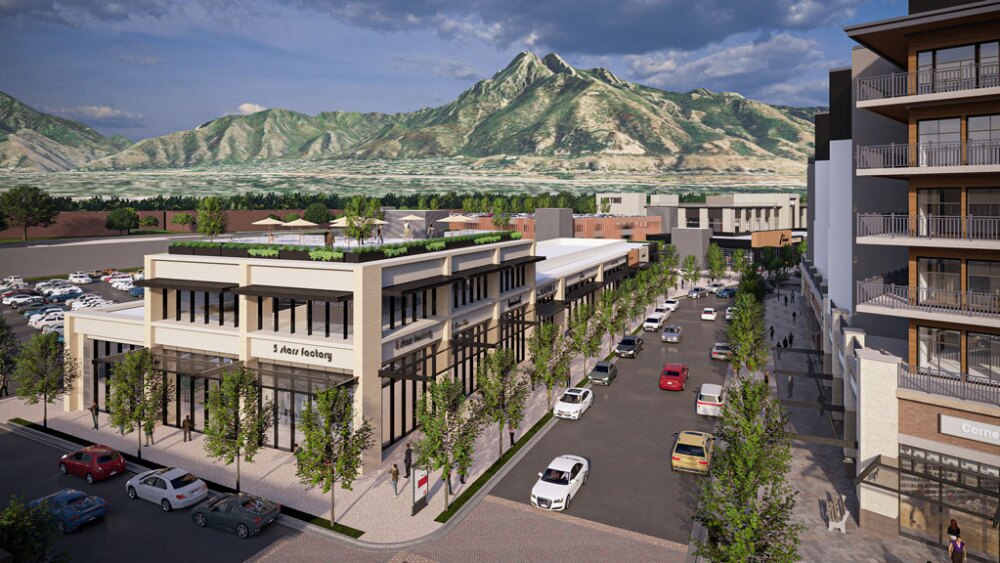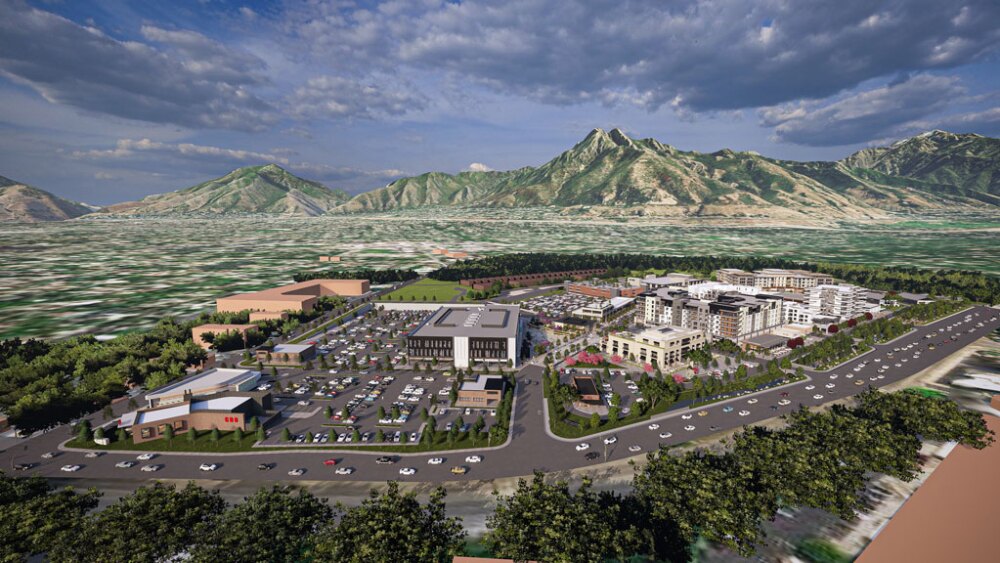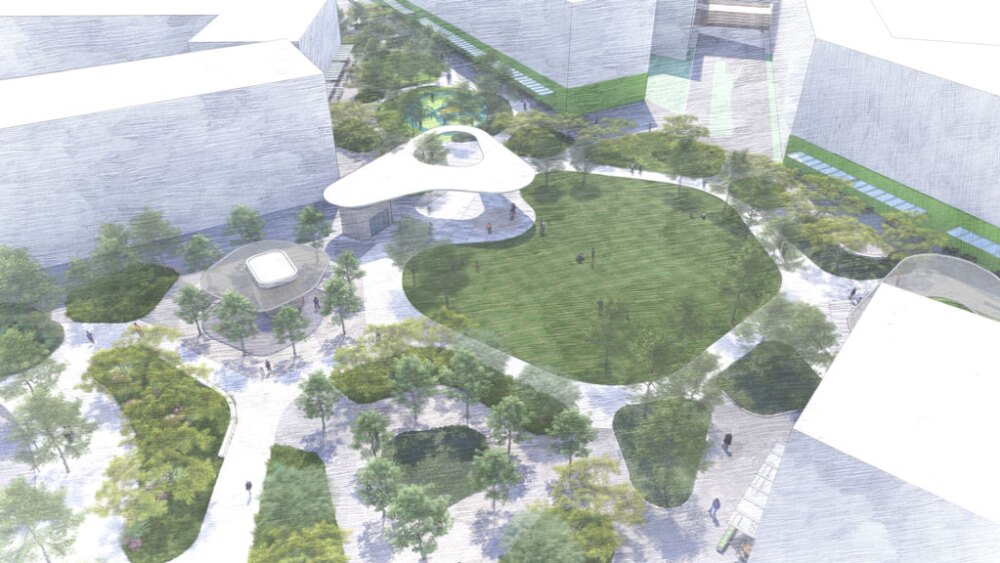Headlines have long proclaimed the demise of the American shopping mall. Despite undeniable shifts in the retail landscape, the truth about these spaces is more nuanced. These massive parcels often stand in prime locations and therefore hold massive potential to sidestep scrap-and-redevelop and to truly evolve.
Any such evolution faces challenges, though, whether from untangling entitlements, reaching consensus across multiple ownership groups, rethinking design and programming needs, or navigating financing in today’s development environment. Any or all of these issues can make such projects extraordinarily complex undertakings.
As communities nationwide reimagine how these shopping centers can serve new generations, development teams strongly benefit from a coordinated effort that considers their process inside and out, combining architecture, urban planning, and landscape architecture teams in a shared vision. At Nelsen Partners and Dig Studio we’ve worked on several such projects, reimagining the design and functionality of several legacy malls around the country, including Metrocenter, Paradise Valley Mall, and Fiesta Mall in Mesa, as well as Holladay Hills in Utah.
Although each project presents its own unique challenges and opportunities, we rely on several guiding principles that help transform these inward-focused shopping destinations into outward-looking community hubs.
1. Public/private partnerships: collaboration is key
As cliché as it sounds, teamwork does make the dream work in mall redevelopment projects. Because these huge tracts of land often have multiple layers of entitlements, it’s critical to consider how public/private partnerships can affect these efforts. Collaboration with the local municipality therefore becomes imperative to help streamline processes, minimize bureaucratic hurdles, and ensure that a cohesive vision is achieved throughout redevelopment.
Projects such as Metrocenter in Phoenix, in which Dig Studio has been involved on both the public infrastructure and the private redevelopment sides, showcase the power of such partnerships, with Phoenix’s investment in a light rail extension becoming an important catalyst for the new development. Additionally, it’s important to consider the rich history these spaces embody in their communities—in some cases spanning multiple generations. Nurturing that public/private partnership can help ensure that the project honors the mall’s history while aligning with the evolving needs of the community.
2. Timing is everything: patience is the key to unlocking potential
With mall redevelopment, patience is a necessity. Malls often represent a complex web of fragmented property ownership and approval rights across various entities, including anchor stores, perimeter pad buildings, and existing retail leases. Navigating these complexities and securing buy-in from all stakeholders can be a time-consuming process that further emphasizes the need for strong public/private collaboration throughout a project.
The story of Paradise Valley Mall in Arizona exemplifies the power of patience. Despite years of planning, previous attempts at redeveloping the mall had failed. The complexity of phasing improvements while parts of the mall remained operational, alongside the challenges of phased planning and approvals, overwhelmed the project. By simplifying the property ownership through acquisition and patiently working with all parties involved, however, a new vision emerged that focuses on creating a mixed-use community center with open space, walkability, and diverse experiences.
Even though waiting certainly poses its own challenges, the time invested up front is likely to pay off tremendously in the long run, as a well-planned, stakeholder-supported redevelopment is much more likely to become a cornerstone of the community.
3. Embrace flexibility with a phased approach to development
The current development landscape is dynamic, to put it kindly, and the traditional “build it all at once” strategy is not always feasible, nor is it necessarily ideal for such massive redevelopment projects as the examples at hand.
Adopting a phased approach for development allows for incremental progress to be made over the course of a project, which helps to ensure harmony between the architectural design and public-realm planning, and which ultimately can lead to a more cohesive and compelling design. Breaking down a mall redevelopment project into smaller phases can also make it easier to adapt to current market conditions and secure funding. Navigating the evolving development landscape requires keen awareness of evolving market dynamics, such as the shifting demand for office space that was prompted by hybrid work, and the recalibration of brick-and-mortar retail in response to more people shopping online. These fluid relationships present significant challenges in envisioning a 10- to 20-year master plan buildout. Embracing a phased development approach not only accommodates these uncertainties but also allows for more flexible adaptation to market demands, ensuring the longevity and relevance of the revitalized mall project. Selling a long-term vision to the city and the community can be challenging, especially when the project will evolve over time. However, ongoing engagement with stakeholders throughout the process will ensure the project remains aligned with community needs as it takes shape over time.
4. Improving circulation: from labyrinth to lively hub
The traditional mall layout often suffers from poor circulation and visibility, hindering accessibility and foot traffic. But what if these developments felt more like a bustling town square, with clear pathways, inviting open spaces, and a sense of easy navigation? Here is where reimagining circulation becomes a powerful tool.
Most American malls typically contain a looped, circular road that makes navigating the space complicated and confusing. The Fiesta Mall in Mesa, Arizona, is no exception. Rather than rely on the pre-existing network of pathways, Nelsen’s efforts are concentrating on transforming the infrastructure into a more navigable and adaptable grid-like system akin to traditional city streets. This approach not only streamlines navigation but also prioritizes development flexibility by creating buildable parcels capable of accommodating various building infill options. It also enables the formation of distinct districts, where such elements as trees, hardscape, furnishings, and lighting can be incorporated to enrich the redevelopment’s ambiance and functionality.
The project also capitalizes on a centralized, activated green space—a “hub”—to create a focal point within the development and overcome the typical loop circulation pattern surrounded by retail pads, which can leave the edges of the development feeling disconnected from the desired urban experience. By drawing people into the heart of the development, the focus shifts toward experiencing the place “inside out.” Prioritizing green, pedestrian-friendly infrastructure not only enhances comfort and encourages exploration but also strengthens the project’s overall sense of place and connection. The redevelopment of the former Cottonwood Mall in Holladay, Utah, is another project where circulation is being improved by reconfiguring streets and replacing surface parking lots with more active, pedestrian-friendly spaces. Addressing infrastructure challenges requires careful planning, but prioritizing accessibility and circulation goes a long way toward creating a lively and connected destination that keeps people coming back.
5. Creating community hubs: honoring the past, shaping the future
Although retail will almost certainly remain a critical component of the overall development, the future of these spaces lies in transforming them into vibrant community hubs, as opposed to simply serving as transactional shopping destinations. The need for these community hubs has become even more imperative amid the rapid decline of “third spaces” in communities around the country.
Ensuring that these developments provide meaningful experiences beyond shopping can be accomplished in several ways, whether by integrating cultural venues such as art galleries or performance spaces or by creating public plazas that can serve as gathering spots for farmers markets, outdoor concerts, or community events. The park space at Paradise Valley Mall, for example, was designed with infrastructure to support a range of performance and community events of various sizes, and with green spaces integrated throughout to ensure an activated feel, even between performances.
Revitalizing malls also requires a delicate balance between preserving their historical significance and incorporating modern amenities. The Paradise Valley Mall redevelopment will celebrate the mall’s significance by paying tribute to several cultural landmarks that were part of the original design, such as the beloved Union Jack entry cubes, which inspired the logo for the new mixed-use development and will be honored throughout the new development and park in other creative ways.
By focusing on integrating unique cultural elements and recreational spaces, developers and designers can enrich the visitor experience, while strengthening the overall success and purpose the space serves in the community.
6. Parking with (re)purpose
The vast parking lots that often surround malls represent a double-edged sword. Whereas multilevel structures are great for density and provide essential parking for visitors, surface-level parking lots are far less desirable. They create enormous expanses of unwalkable, underused space and act as heat islands by absorbing and radiating heat, making the surrounding areas less comfortable, vibrant, and viable. However, opportunities exist to transform these parking lots from liabilities into valuable assets that enhance a project’s appeal and contribute to its success.
The key lies in strategic repurposing—instead of demolishing existing parking structures, in particular, we consider how they can be integrated into the new development for use in multifamily housing or mixed-use developments. Doing so helps to maximize use of space and also enhances a project’s appeal to developers (after all, parking is a premium) and mitigates the urban heat island effect by replacing asphalt lots with buildings or green spaces.
No preordained script exists for revitalizing American malls, and each project presents its own opportunities and challenges, but these local landmarks can take on new life as vibrant hubs where commerce, culture, and community thrive. Regardless of each community’s goals, the common component that these projects exemplify is the public/private collaboration. That remains the single biggest key to a successful undertaking on large-scale projects of this nature. Through early and frequent cooperation between developers and city staff, communities can achieve more adaptable, vibrant public places.










